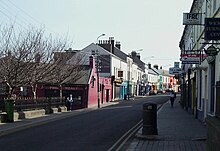Wicklow
Wicklow (Irish: Cill Mhantáin, meaning 'Church of the Toothless One') is the county seat of County Wicklow in Ireland. Located south of the capital Dublin on the east coast of the island, it has a population of 10,070[1] according to the 2006 census.
The town lies off the N11 route between Dublin and Wexford. Wicklow is also connected to the rail network with Dublin commuter services now extending to the town. Additional services connect with Arklow, Wexford and Rosslare Europort, a main ferry port. There is also a commercial port, mainly importing timber and textiles.
History
Local history contends that the town of Wicklow was founded by the Vikings, probably around 795 AD. The name 'Wicklow' comes from Vikinglow, meaning Meadow of the Vikings, or Wykynlo, meaning Viking Loch. However, given the town's natural harbour and rich agricultural surrounds, it is not surprising that the area was an established settlement prior to the 9th century.[2]
The origin of the Irish name Cill Mhantáin has an interesting folklore of its own. Saint Patrick is said to have attempted to land on Travailahawk beach, to the south of the harbour. Hostile locals attacked the landing party causing one of the saint's party to lose his front teeth. Manntach (toothless one), as he became known, was undeterred and returned to the town, eventually founding a church. Hence Cill Mhantáin, meaning Church of the Toothless One, although there is no evidence, material or written, for the existence of such a local holy man.
The English-language 'Wicklow' placename bears no relation to the Irish Cill Mhantáin. The Normans, who came to dominate the area, preferred the non-Gaelic placename. The Norman influence can still be seen today in some of the town's place and family names.

After the Norman invasion, Wicklow was granted to Maurice FitzGerald who set about building the 'Black Castle', a land-facing fortification that lies ruined on the coast immediately south of the harbour.
The surrounding County of Wicklow is rich in bronze age monuments. The oldest surviving settlement in the town is the Franciscan Abbey, located at the west end of Main Street, within the gardens of the local Roman Catholic parish grounds.
Other notable buildings include the Town Hall and the Gaol, built in 1702 and recently renovated as a heritage centre and tourist attraction. The East Breakwater, arguably the most important building in the town, was built in the early 1880s by Wicklow Harbour Commissioners. The architect was William George Strype and the builder was John Jackson of Westminster. The North Groyne was completed by about 1909 - John Pansing was the designer and Louis Nott of Bristol the builder. The Gaol was a place of execution up to the end of the 19th century and it was here that Billy Byrne, a leader of the 1798 rebellion, met his end in 1799. He is commemorated by a statue in the town square. The gaol closed in 1924 and is today a tourist attraction with living displays and exhibits.[3]
At Fitzwilliam Square in the centre of Wicklow town is an obelisk commemorating the career of Captain Robert Halpin, commander of the telegraph cable ship Great Eastern, who was born in Wicklow in 1836.[2]

Geography
Wicklow town forms a rough semicircle around Wicklow harbour. To the immediate north lies 'The Murrough', a popular grassy walking area beside the sea, and the eastern coastal strip. The Murrough is a place of growing commercial use, so much so that a road by-passing the Town directly to the commercial part of the area commenced construction in 2008. The land rises into rolling hills to the west. The dominant feature to the south is the rocky headlands of Bride's Head and 'Wicklow Head', the easternmost mainland point of the Republic of Ireland.
A changing town
Since 1995, the town has undergone significant change and expansion reflecting the simultaneous growth in the Irish economy. Considerable residential development has taken place to the southwest of the town along Marlton Road (R751). More recently, housing developments have been concentrated to the northwest of the town towards the neighbouring village of Rathnew. The completion of the Ashford/Rathnew bypass in 2004 has meant that Wicklow is now linked to the capital, Dublin, lying 42 km to the north, by dual carriageway and motorway. These factors have led to a steady growth in population of Wicklow and its surrounding townlands while its importance as a commuter town to Dublin increases.
References
- ^ Population CSO 2006
- ^ a b The illustrated road book of Ireland. Automobile Association. 1970.
- ^ S Shepherd; et al. (1992). Illustrated guide to Ireland. Reader's Digest.
{{cite book}}: Explicit use of et al. in:|author=(help)
Bibliography
- Cleary, J and O'Brien, A (2001) Wicklow Harbour: A History, Wicklow Harbour Commissioners

